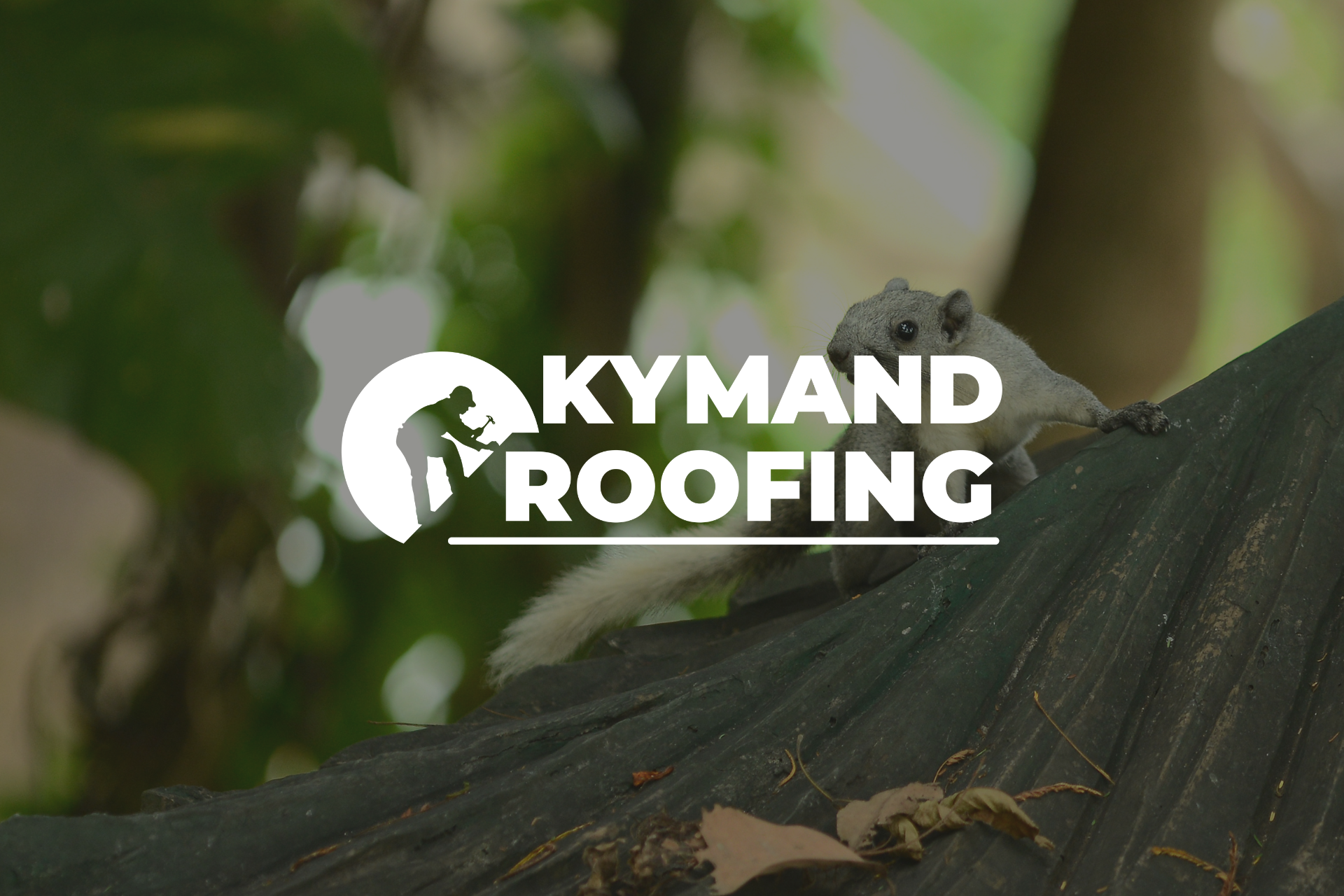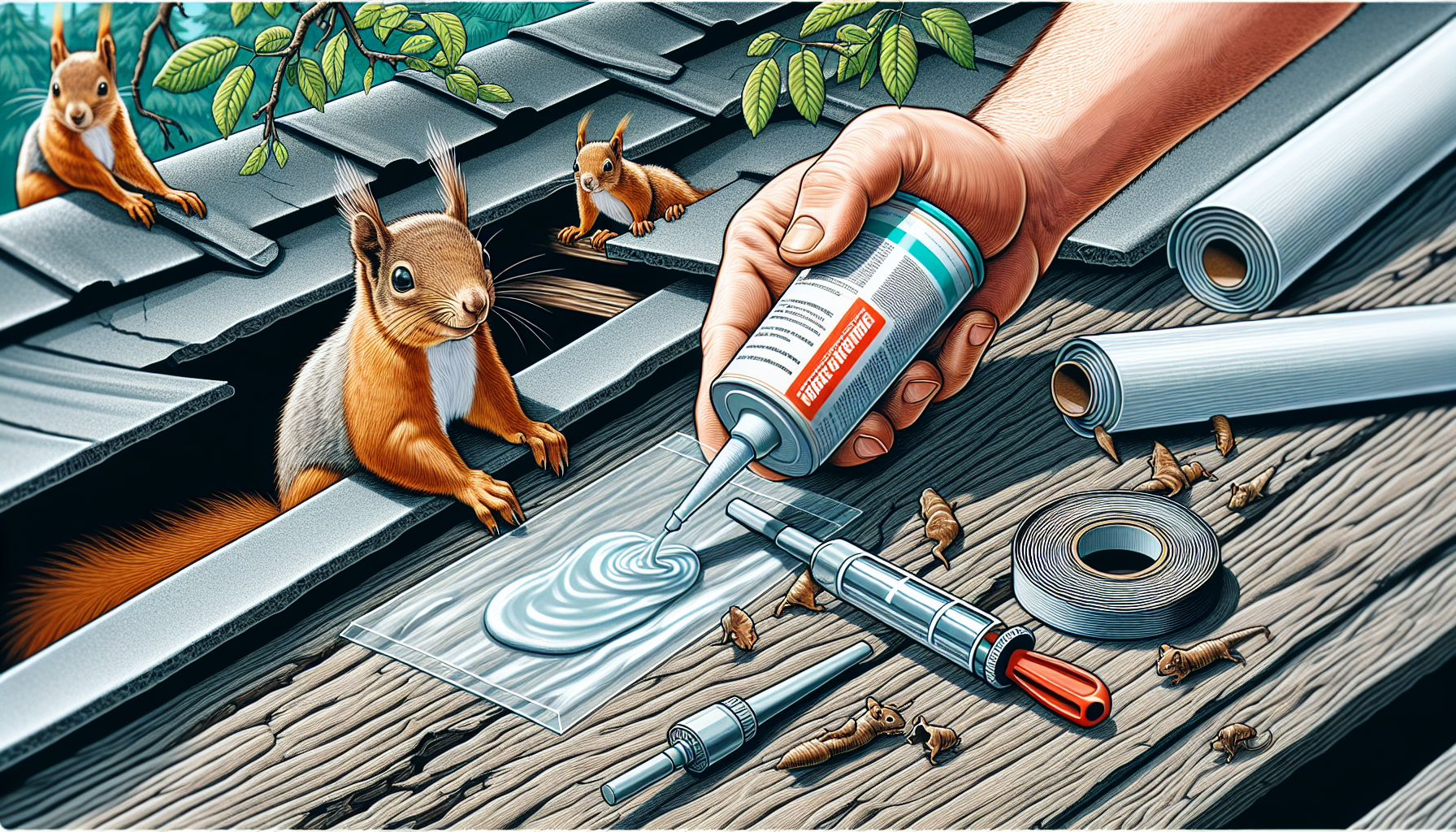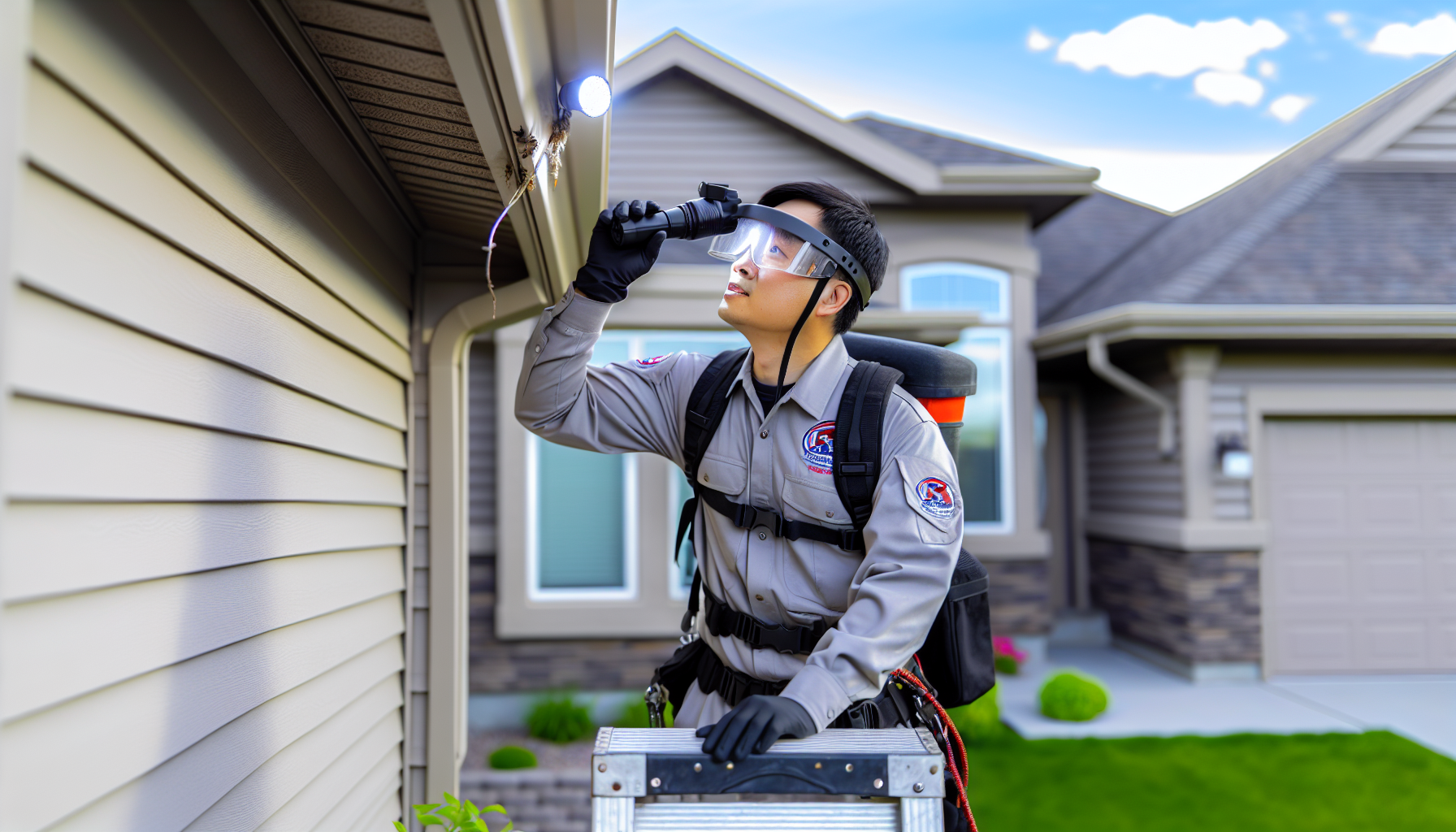6020 2 St SE B4, Calgary, AB
The Ultimate Guide to Eliminating Squirrels in Roof Spaces
Kymand Roofing Inc. - Blog - Roofing

By Kymand Roofing Inc.
Roofing
0 Comment
If you’ve got “squirrels in roof”, you need solutions, not noise. This article tackles the pesky problem head-on, offering practical advice to identify and eliminate your uninvited attic guests.
Eliminating Squirrels in Roof Spaces
Key Takeaways
- Early identification of squirrels in roof spaces through noises, droppings, and damage to insulation and wiring is essential for
preventing extensive damage
and enabling effective removal.
- Practical DIY solutions for squirrel removal include exclusion techniques, humane trapping, and natural deterrents, while preventing future incursions requires sealing entry points, tree maintenance, and squirrel-proof bird feeders.
- Professional pest control services are recommended when dealing with persistent infestations, health and safety concerns, or when repair and cleanup of damage caused by squirrels is necessary.
Identifying Squirrels in Your Roof

Unwanted guests can be a problem, especially if they’re as crafty and nimble as squirrels. These creatures are
experts at finding their way into homes, often taking up residence in the warm, safe confines of your roof. But how do you confirm a squirrel infestation?
Well, several signs can point to the presence of these pesky critters. Remember, early identification is key to preventing extensive damage and ensuring effective removal. We’ll now examine the indicators of their presence.
Noises and Activity
Firstly, your ears can prove to be the best detection tool. Squirrels are far from quiet house guests. Their daily antics in your attic can
create a variety of noises. The sound of scratching, scurrying, or rolling acorns are telltale signs of squirrel activity. Keep in mind, these sounds are often more noticeable during daytime since squirrels are active during this period.
Differentiating between squirrel noises and other pest noises can be tricky. The distinctively loud scurrying, scampering, and
scratching sounds, often accompanied by
high-pitched squeaks, are usually a dead giveaway. If in doubt, seeking advice from a pest control specialist is recommended.
Droppings and Odors
Another sign of a squirrel infestation is the presence of squirrel droppings and strong odors, which can sometimes be found near a squirrel nest. Squirrel droppings are initially dark brown, becoming lighter with age. They are slightly thicker and more oblong-shaped compared to other rodent droppings, such as those from rats.
Beyond their unsightly appearance,
squirrel droppings also present health hazards. They can harbor hazardous bacteria like
salmonella and leptospirosis. If a squirrel infestation is suspected, it’s advisable to engage a professional for safe cleanup and removal.
Damage to Insulation and Wiring
Squirrels aren’t just a nuisance; they can cause serious damage to your property. They are notorious for gnawing on a variety of materials, including insulation and electrical wires. This can significantly increase the risk of fire, making it essential to inspect your attic for any signs of damage. If you’re wondering how many squirrels it takes to cause such damage, even a single one can be a potential threat.
Look for the following signs of squirrels:
- Tears in the insulation
- Chewed holes in soffit and roof decking
- Trampled down insulation
- Feces and urine stains
These signs not only indicate the presence of squirrels but can also help you identify the areas they’re using to gain access to your roof.
How Squirrels Enter Your Roof

Having recognized the indicators of a squirrel infestation, it’s time to understand how these animals manage to infiltrate our roofs. Squirrels are incredibly agile creatures; they can fit through openings as small as 1 ½ inches wide and are capable of chewing through a variety of materials.
Understanding the squirrel’s entry methods is crucial to their removal and prevention of future infestations. Their accessibility points can vary from gaps and openings,
vents and chimneys, to
nearby trees and branches. Let’s explore these entry points in detail and determine how to reinforce the entry point.
Gaps and Openings
Gaps and openings are the most common entry points for squirrels. These agile creatures can squeeze through openings as small as 4cm wide, which is equivalent to the size of a golf ball. They can even chew through various materials
such as wood, aluminum, and plastic to create their own entry points.
How can you identify these small entrances? A thorough inspection of your house, focusing on roof vents, soffit areas, and eave vents should do the trick. Look for poorly screened areas, gnawing marks, and small droppings around these areas. Keep in mind, pinpointing these entry points marks the beginning of your journey to a squirrel-free home.
Vents and Chimneys
Vents and chimneys offer another highway for squirrels into your home. These critters are skilled climbers and can easily scale the sides of houses to access these points. They can chew through materials such as plastic vents and breach damaged chimney caps to gain entry into roofs.
Installing chimney caps made of durable materials like stainless steel or copper could be a preventive measure. These prevent squirrels from gaining access while allowing smoke to exit. If squirrels are already inside your chimney, you can encourage them to leave by making noise or providing a rope for them to climb out.
Nearby Trees and Branches
Squirrels are natural climbers, and trees offer a convenient route to your rooftop. Especially if tree branches hang near or over your roof, squirrels can easily jump across and gain access. Hence, maintaining the trees around your property regularly is fundamental in preventing squirrel invasions.
Trimming back branches that are close to the roof can help deter squirrels from gaining access. A distance of 6-8 feet between the tree branches and your roof is recommended. Additionally, wrapping the trunk of the tree with a sheet of metal can also discourage squirrels from climbing.
DIY Solutions for Removing Squirrels

Having identified the signs of a squirrel infestation and the potential entry points, the logical next step is to figure out how to remove these unwelcome guests. A variety of
DIY solutions
can assist you in addressing a squirrel problem prior to seeking professional assistance.
These solutions range from exclusion techniques and humane trapping to natural deterrents. Each of these methods can be effective in its own way, depending on the extent of the infestation and the particular circumstances of your home.
Exclusion Techniques
Exclusion techniques are an
effective way to eliminate squirrels from your roof spaces. The principle behind exclusion is simple - allow the squirrels to leave for food, but prevent them from coming back in. This can be accomplished by
setting up one-way doors or employing barriers such as
wire mesh or metal flashing
to seal entrances.
However, before installing a one-way door, confirm there are no baby squirrels left inside. If a mother squirrel is locked out while her babies remain inside, she will cause significant damage trying to get back to her young. Moreover, the babies will not survive without their mother, leading to other problems like foul odors from decaying bodies. It is essential to consider the presence of mother squirrels and their offspring when dealing with such situations.
Humane Trapping
If exclusion isn’t practical or successful, another option is humane trapping using squirrel traps. Live-capture traps enable you to catch the squirrels without causing them harm. Once trapped, the squirrels should be released at a considerable distance from your property to deter them from coming back.
Humane traps should be baited with foods like peanut butter, which squirrels find irresistible. Remember to check the traps frequently to ensure any captured squirrels can be released promptly. After the removal of all squirrels, it’s essential to close all entry points to avert a new intrusion.
Natural Deterrents
Natural deterrents can also be an effective way to keep squirrels away. These methods are non-lethal and don’t involve capturing the squirrels. Instead, they rely on making your roof space less appealing to squirrels.
Bright lights and noise can be effective deterrents as squirrels prefer quiet, dark spaces for nesting. In addition, natural repellents like apple cider vinegar or peppermint oil can be used. These substances have strong smells that squirrels find unpleasant. Regularly applying these repellents around potential entry points can discourage squirrels from coming near.
DIY Solutions for Removing Squirrels

Having gone through the process of identifying and removing squirrels from your roof, the last thing you want is a repeat infestation. The good news is that there are
steps you can take to prevent future squirrel infestations.
These preventative measures include sealing entry points, maintaining trees around your property, and using squirrel-proof bird feeders. Implementing these measures significantly decreases the likelihood of squirrels reinfesting your roof.
Sealing Entry Points
The first step in preventing a future squirrel infestation is to
seal all potential entry points. This encompasses all gaps or openings that squirrels could exploit to infiltrate your roof. Sealing these points is crucial, as even the smallest gap can be exploited by a determined squirrel.
Materials such as caulk, sealant, or metal flashing can be used for this purpose. It’s important to periodically check your roof for any damage or wear and tear that could lead to new entry points. Promptly repairing any deteriorating wood or other materials can also help to keep squirrels out.
Tree Trimming and Maintenance
As we mentioned earlier, squirrels can use nearby trees as a pathway to your roof. Therefore,
regular tree maintenance is a crucial part of preventing squirrel infestations. This includes trimming branches that are too close to your roof and wrapping tree trunks with metal sheeting to deter squirrels from climbing.
Remember, a distance of 6 to 8 feet between tree branches and your roof is recommended. This distance is typically too far for squirrels to jump, making it harder for them to reach your roof.
Squirrel-Proofing Bird Feeders
Finally, if you have bird feeders in your yard, consider using
squirrel-proof models. Bird feeders can lure squirrels onto your property by offering a readily available food source. This can be particularly problematic if the bird feeder is located near your house, as it can lead the squirrels to discover your roof.
Squirrel-proof bird feeders are designed to prevent squirrels from accessing the food, while still allowing birds to feed. These feeders can be an effective way to enjoy bird watching in your yard without inadvertently inviting squirrels into your home.
When to Call a Professional

While the DIY methods we’ve discussed can be effective in dealing with squirrel infestations,
sometimes it’s best to call in the professionals. If your squirrel problem persists despite your best efforts, or if you have health and safety concerns, it’s time to call a
professional pest control company.
Professional pest control services can help with squirrel infestations by:
- Providing expertise and equipment for safe and efficient removal
- Assisting with damage repair and cleanup after an infestation
- Ensuring your home is restored to its original condition
Persistent Infestations
If you’ve been trying to deal with a squirrel infestation for some time without success, it’s time to call a professional. Persistent infestations can be difficult to handle without professional help, especially if the squirrels have established a nest in your roof.
Professionals in pest control employ sophisticated strategies to eradicate squirrels and inhibit their return. They can also help to identify and seal all potential entry points, ensuring that your squirrel problem is dealt with comprehensively.
Health and Safety Concerns
Squirrel infestations can pose significant health and safety risks. Squirrels can carry and transmit diseases such as:
- Salmonellosis
- Lyme disease
- Leptospirosis
- Encephalitis
- Tularemia
Furthermore, they can cause serious damage to your property, including the risk of fire due to their habit of gnawing on electrical wires.
If you have concerns about these health and safety risks, it’s best to hire a professional. Equipped with the necessary training and tools, they can manage these risks safely to safeguard you and your home.
Damage Repair and Cleanup
After a squirrel infestation, it’s often necessary to undertake repairs and cleanup. Squirrels can cause significant damage to your roof, insulation, and electrical wiring. They also leave behind droppings and nesting materials which need to be cleaned up to prevent health risks.
Professional pest control services, such local exterminators, can undertake the process of cleanup and repair on your behalf. They have the knowledge and tools to do this work safely and effectively, saving you time and stress.
Summary
To wrap it up, dealing with a squirrel infestation in your roof is no small task. It requires keen observation, a good understanding of squirrel behavior, and, in some cases, professional help.
However, by following the steps we’ve outlined, you can effectively identify, remove, and prevent squirrel infestations in your roof. Remember,
the key is to act quickly and decisively. The longer squirrels have to establish themselves in your roof, the harder it will be to remove them.
Frequently Asked Questions
How can I get a squirrel out of my attic?
You can use natural squirrel repellents like apple cider vinegar, black pepper, garlic, and peppermint to repel squirrels from your attic. Soaking a rag in one of these ingredients and placing it near the nest or entry point can discourage them from returning.
How long does it take for squirrels to leave the attic?
Squirrels typically leave the attic when their babies are about 4 months old and independent from their family groups.
What does a squirrel sound like in the attic?
If you hear scurrying, scampering, scratching, rolling, gnawing, or grinding sounds in your attic, it's likely that squirrels have taken up residence. Their activity can be fairly loud due to their size.
Do squirrels move around in attic at night?
No, squirrels do not usually move around in the attic at night. If you hear activity during the night, it's more likely to be caused by nocturnal animals like raccoons or rats, rather than squirrels.
What smells do squirrels hate in the attic?
Squirrels hate the scents of peppermint oil, capsaicin, and coffee grounds, among others, so using these scents in your attic can help deter them.
Our Services
Newsletter
Subscribe For Daily Latest News & Updates
Contact Us
We will get back to you as soon as possible.
Please try again later.
Open Hours
Monday: 8:00 AM - 6:00 PM
Tuesday: 8:00 AM - 6:00 PM
Wednesday: 8:00 AM - 6:00 PM
Thursday: 8:00 AM - 6:00 PM
Friday: 8:00 AM - 6:00 PM
Saturday: 8:00 AM - 6:00 PM
© Copyright Kymand Roofing Inc 2025. All Rights Reserved. Design and SEO by Purple Penguin Media


